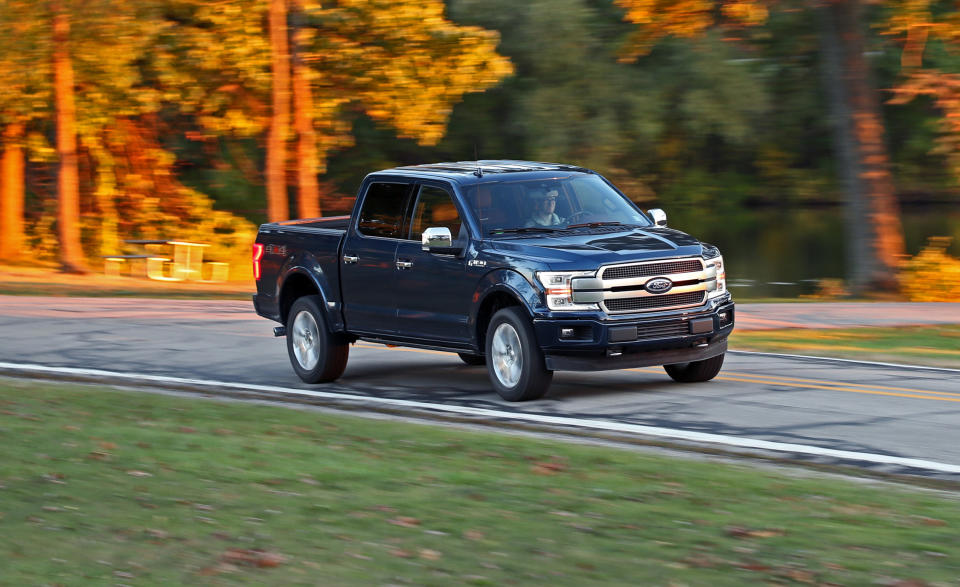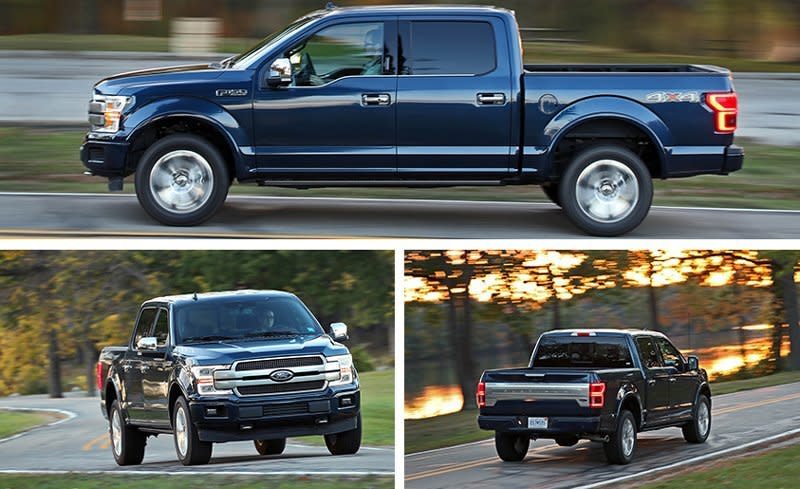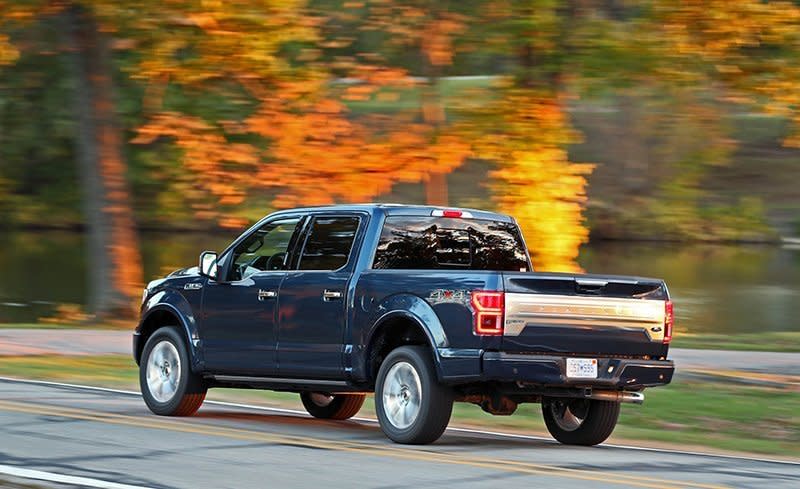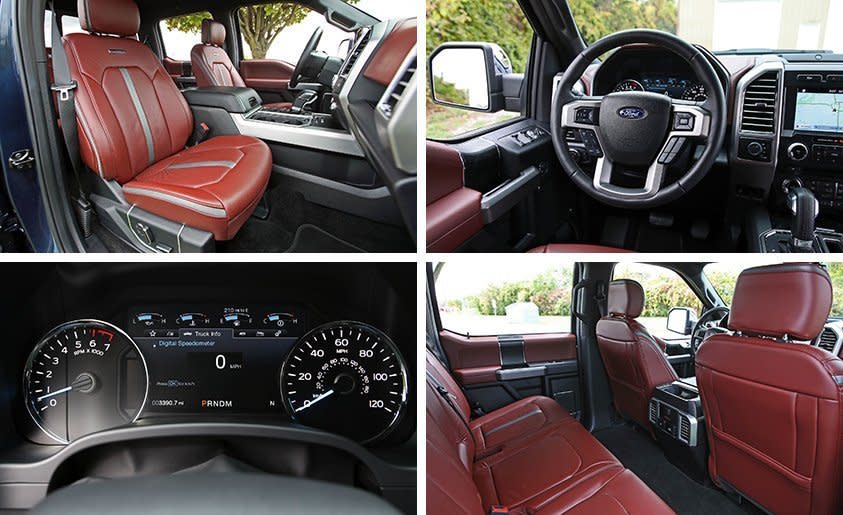2018 Ford F-150 5.0L V-8 4x4 SuperCrew

At its core, the domestic pickup truck is a rudimentary device: a collection of boxes riding on a ladder frame underpinned by at least one solid axle, with a front-mounted engine and transmission. Brilliantly simple from the start, the basic formula hasn’t had to evolve much to keep its place in the food chain. Even with a host of unprecedented advancements coming online in the last decade or so—turbocharging, active suspensions, transmissions with up to 10-speeds, lightweight materials, and a bevy of innovations in safety and driver-assistance tech—its primary appeal remains an ability to haul people in relative comfort while their unwieldy and often messy stuff rides in back. The blueprint hasn’t changed much for a reason.
Take the 2018 Ford F-150 Platinum tested here. Second only to the Limited in the Ford F-150 trim hierarchy (the F-150 Raptor is on a wholly different branch of the family tree), it sports an aluminum body and a 10-speed automatic transmission but relies on a naturally aspirated V-8 for motivation. An advanced and capable example of the eight-pot species, the latest version of Ford’s 5.0-liter engine also placates the dwindling contingent of traditionalists who may never cotton to the notion of a turbocharged V-6 pickup. While Ford claims 65 percent of F-Series buyers opted for one of its EcoBoost twin-turbo V-6s in 2017—30 percent choosing the 3.5-liter and 35 percent going with the 2.7-liter—the V-8 isn’t going away soon.

8 X 10
Rated at 395 horsepower and 400 lb-ft of torque, the 5.0-liter has been upgraded for 2018 with a port and direct fuel-injection system to improve efficiency, drivability and emissions, along with spray-in bore liners to squeeze as much mass out of the aluminum block as possible while enhancing durability. (The 5.2-liter flat-plane V-8 in the Shelby Mustang GT350 employs the latter technology as well.) Producing 10 more ponies for 2018, the naturally aspirated V-8 wins one for the old guard by eking out a 20-hp victory over Ford’s 375-hp twin-turbo 3.5-liter EcoBoost V-6. The celebration is short-lived, though, as the storied V-8’s torque figure falls a full 70 lb-ft shy of the EcoBoost’s 470 lb-ft.
Despite being somewhat grunt deficient versus the boosted six, the upgraded V-8 has little trouble returning solid results at the test track. Propelling the 5284-pound pickup from zero to 60 mph required just 5.9 seconds, only 0.2 second slower than the last 2017 F-150 with the 3.5-liter EcoBoost and 10-speed we tested. It’s also a 0.4-second improvement over a 2016 F-150 Supercrew 4x4 with that year’s less-powerful V-8 and six-speed automatic. The 2018 V-8 also ran the quarter-mile in 14.4 seconds, matching the EcoBoost’s time precisely. It even cleared the traps doing 98 mph—one mph faster than the EcoBoost. (The earlier V-8 truck ran the quarter in 14.9 seconds at 95 mph.)

Results are mixed when the Ford lines up against its bow-tie nemesis. While it easily lays waste to the 7.2- and 15.4-second times posted by the last 2016 Chevrolet Silverado with the 5.3-liter and eight-speed transmission that we tested, it can’t match the 5.7- and 14.3-second times laid down by a 2017 Silverado with the 6.2-liter V-8. A 2016 GMC Sierra 1500 with the 6.2-liter we took to the track was just a bit quicker, getting to 60 mph in 5.6 seconds and running the quarter in 14.0 flat. The bigger takeaway from this set of tightly grouped numbers is how Ford and General Motors get similar results from disparate hardware and engineering philosophies.
Ford’s version of the 10-speed transmission that it co-developed with GM is a willing dance partner, albeit with two missteps. First, intuitively squeezing the release and tugging the console-mounted shifter rearward frequently bypasses the weak detent for drive and instead lands a notch rearward in the manual-mode position, which inattentive drivers may not notice until the engine is spinning at a raucous 5000 rpm in first gear. A more authoritative manual-mode lockout would be welcome. A second issue involves harsh downshifts at speeds below 30 mph. Lean in to the accelerator aggressively from a slow roll and the transmission occasionally rewards you with a clumsy and harsh downshift that’s impossible to ignore. Our long-term F-150 Raptor with the same 10-speed shares both of these minor annoyances but has yet to throw a code or leave a trail of hardware on the road.

While the F-150’s observed 15 mpg fuel-economy figure falls about where we expected it to, we were mildly surprised when it returned 19 mpg in our 75-mph highway test. Both figures exactly match the fuel economy we measured in the F-150 with the 3.5-liter EcoBoost V-6. That gives the V-8 truck a 430-mile highway range with the standard 23.0-gallon tank; an optional 36.0-gallon tank is available for $445.
While the brakes and suspension are less innovative than the drivetrain, the chassis delivers competitive performance. This F-150 SuperCrew needed 180 feet to stop from 70 mph, roughly on par with the competition. The pedal is of the strong silent type, but its predictable response makes it easy to slow the vehicle without tossing heads or pitching items off the seats. Likewise, the truck’s 0.80-g grip figure is more than sufficient for a pickup, but the real story is the refined ride/handling tradeoff. While the GM trucks can feel more planted when cornering and the Ram 1500 delivers a plusher low-speed ride, the F-150 offers the best blend of attributes, impressive for a pickup wearing mildly aggressive 20-inch 275/55R-20 Hankook DynaPro AT-M all-season/all-terrain tires.

Platinum Denim
Both Car and Driver staffers and total strangers commented on this F-150 test truck’s exterior finish. The Blue Jeans Metallic paint contrasts nicely with the interior’s dark red Marsala leather seating and trim. A spray-in bedliner lent a little brawn to the beauty for $495, and the $2540 Preferred Equipment Group 701A added some sensible conveniences such as lane-keeping assist, active park assist, adaptive cruise control with stop-and-go functionality, pre-collision assist with pedestrian detection, and a 360-degree camera with a split-view display and Dynamic Hitch Assist. Not to be confused with Ford’s Pro Trailer Backup Assist (PTBA), which actively helps you steer the truck via a dash knob, Dynamic Hitch Assist presents a set of graphic guides on the touchscreen display to make it easier for the driver to place the hitch directly under the trailer tongue on the first try. Adding PTBA would require selecting the $995 Trailer Tow Package or the $1295 Max Trailer Tow Package. Speaking of towing, our test truck was rated to pull 9000 pounds, but you can increase that rating up to 11,600 pounds by opting for the Max Trailer package and a 6.5-foot bed.

Woodgrain interior accents, premium audio, and voice-activated navigation are included with the Platinum trim level as standard kit. All in, our F-150 SuperCrew wore an as-tested sticker of $61,745.
Combined with the sheer number of powertrain options, trim levels, body/bed combinations, purpose-built performance models, and the frivolous proliferation of special editions, there have never been more ways to get your half-ton truck on. As impressive as all the new technology is, the numbers don’t lie: There’s still plenty of life left in the traditional V-8, if the word “traditional” can indeed be applied to a dual-overhead-cam, four-valve, dual-injected, all-aluminum engine.
Specifications >
VEHICLE TYPE: front-engine, rear/all-wheel-drive, 5-passenger, 4-door pickup
PRICE AS TESTED: $61,745 (base price: $41,050)
ENGINE TYPE: DOHC 32-valve V-8, aluminum block and heads, port and direct fuel injection
Displacement: 307 cu in, 5038 cc
Power: 395 hp @ 5750 rpm
Torque: 400 lb-ft @ 4500 rpm
TRANSMISSION: 10-speed automatic with manual shifting mode
DIMENSIONS:
Wheelbase: 145.0 in
Length: 231.9 in
Width: 79.9 in Height: 77.2 in
Passenger volume: 136 cu ft
Curb weight: 5284 lb
C/D TEST RESULTS:
Zero to 60 mph: 5.9 sec
Zero to 100 mph: 14.9 sec
Rolling start, 5–60 mph: 6.4 sec
Top gear, 30–50 mph: 3.3 sec
Top gear, 50–70 mph: 4.4 sec
Standing ¼-mile: 14.4 sec @ 98 mph
Top speed (governor limited): 107 mph
Braking, 70–0 mph: 180 ft
Roadholding, 300-ft-dia skidpad: 0.80 g
C/D FUEL ECONOMY:
Observed: 15 mpg
75-mph highway driving: 19 mpg
Highway range: 430 mi
EPA FUEL ECONOMY:
Combined/city/highway: 18/16/22 mpg

 Yahoo Autos
Yahoo Autos 